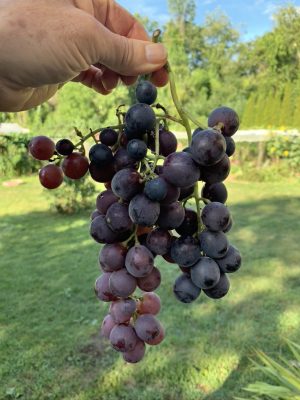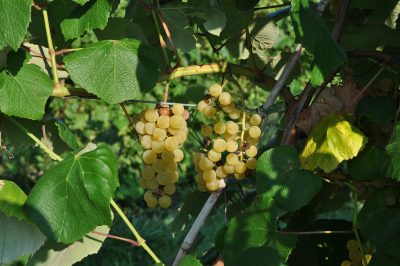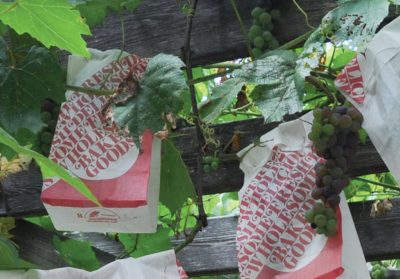DAILY GRAPES
As The World Turns…
Over the years, gardening has made me more and more aware of our planet’s annual track around the sun. How quaint. It gives me a certain kinship with the peasants at work in the 15th century painting for the month of September of Les Très Riches Heures de Duc de Berry.

Picking grapes, 15th and 21st century
As with those peasants, September is a month when I have abundant fruits for harvest. Like the peasants, I’m harvesting grapes; it’s been a bumper year. Unlike the peasants, my grapes are destined for fresh eating rather than being sullied by fermentation into wine. (Okay, okay, just kidding, although I am not a fan of drinking wine.)
First to ripen here were the varieties Somerset Seedless and Alden. With an abundance of varieties and fruits, I can afford to be picky, so this will be the last season here for Somerset Seedless. It’s too prone to pest problems and the fruit never loses enough of its tannin-y taste for my palate.

Alden grape
Alden is also threatened with my saw and shovel because it bears lightly and is also plagued with pest problems. But excellent taste and texture make it worth keeping.
Following on the heals of those earlier varieties are Swenson Red, Lorelei, Glenora, and Vanessa. The latter two are very good but would not be worth keeping if they weren’t seedless. In my experience, the most flavorful grapes are those with seeds. Swenson’s Red is a variety that pretty much everyone loves. They’d also love Lorelei if they got to taste this not very common variety.
Finally come Edelweiss, Wapanuka, Brianna, and, bearing for the first time, Cayuga White. The first three are not yet quite ripe. Even at this stage, they are delectable. Cayuga White is still proving itself, or not.

Edelweiss
Looking to the future, newly planted Bluebell, Alpenglow, and Dr. Goode should yield a few berries next year. Also an unknown variety that I propagated from an old vine growing at a friend’s Orchard.
With their bold flavors, you’re not likely to find any of the varieties I mentioned at a supermarket, possibly even a farmer’s market. Plant them!
Variety Choices
A few caveats: The Wallkill River Valley, site of my farmden, is far from ideal for fruit growing. As a valley, it’s colder than surrounding land (zone 5) and is laden with damper air that encourages disease. An abundance of wild grapevines in the bordering 6000 acres of forest provides a place for insects and disease to get their start.
Nonetheless, I get good crops without resorting to sprays. This is possible by providing a sunny site with good air circulation and making the best of it with trellises, and — very important — annual pruning. Also by choosing varieties to plant based on pest, disease, and cold resistance.
Many grape varieties are hybrids of European and American species, the Europeans chosen for their flavor (flavor, that is, from a Eurocentric perspective), the Americans for their toughness to pests and more rigorous growing conditions. American varieties have a unique flavor, called foxiness and typified by that of Concord, as well as a slip skin. European varieties are sweet with a crunchy texture.
As far as flavor and texture, varieties span the spectrum from those that are more like European grapes to those more like American grapes. My final, but very important, consideration in choosing a variety is flavor, and I mostly prefer the flavors of varieties toward the American end of the spectrum.
Of course, the choice widens for grape enthusiasts in more Mediterranean climates, where European varieties can also be grown, and in the Southeast, where the native muscadine grapes grow wild and are cultivated.
Bagging, for Pests
Many birds and insects, especially yellow jackets and European hornets, also enjoy my grapes. They leave plenty for me, but crucial to harvesting the best of the best tasting grapes here is bagging.
Years ago I figured that the longer a bunch of grapes hangs on the plant, the tastier it gets (to a point), but also the more chance of attack by insects and birds. So I bought 1000 bakery bags that happened to have “Wholesome Fresh Delicious Baked Goods” printed on them.  Perhaps the label made the bags even less attractive to grape-hungry birds and insects; at any rate, they worked very well, usually yielding almost 100 late harvest, delectably sweet and flavorful, perfect bunches of bagged grapes each year.
Perhaps the label made the bags even less attractive to grape-hungry birds and insects; at any rate, they worked very well, usually yielding almost 100 late harvest, delectably sweet and flavorful, perfect bunches of bagged grapes each year.
This year, I thought organza bags might work well.  Organza is an open weave fabric often made from synthetic fiber. Small organza bags typically enclose wedding favors; the bags come in many sizes. Organza bags have the advantage over paper bags of letting in more light. A mere pull of the two drawstrings makes bagging the fruit very easy; paper bags involve cutting, folding, and stapling. Organza bags also re-usable. (The bags also work well with apples which, in contrast to grapes, require sunlight to color up.)
Organza is an open weave fabric often made from synthetic fiber. Small organza bags typically enclose wedding favors; the bags come in many sizes. Organza bags have the advantage over paper bags of letting in more light. A mere pull of the two drawstrings makes bagging the fruit very easy; paper bags involve cutting, folding, and stapling. Organza bags also re-usable. (The bags also work well with apples which, in contrast to grapes, require sunlight to color up.)
In the15th century painting, peasants just pile bunches of their grapes into large, wooden tubs. I gently set only enough bunches for immediate consumption into a woven basket. Different methods, but we’re all tuned to the progress of our planet around its sun.
More details about growing grapes — and lots of other fruits — in my book Grow Fruit Naturally.



Informative and inspiring, as always. Thanks!
I like the look of the organza bags better, and wouldn’t have to worry about airflow or overheating compared to the waxed bakery bags, either.
It looks like you have organza and bakery bags side-by-side in the last grapes photo. Is that an intentional comparison trial?
Yes. I’ve used bakery bags for years. This is the first year with organza, and I’m pleased with the results, their ease of application, and the fact that they cann be re-used.
Lee:
You never fail to amaze me with the horticultural items you grow. Now it is a collection of Grapes. I have two types of grapes Interlaken and Concord. I haven’t done much with them except leave them for the deer and birds. I have thought of bagging the grapes and I like your solution of the Organza Bags. I will try this next season. I’ll keep you posted with my results.
Many Thanks, kf
I thought one of the reasons for bagging grapes was to protect against diseases like black rot. Would the organza bags work against that, or are they too permeable? Is black rot not enough of a problem where you are to take that into consideration? Trying to figure out what might be useful in a mid-atlantic region with tons of summer humidity.
Good question. Yes, my grapes do get black rot. And I would expect that the spores could enter the bags. But I haven’t seen hardly any black rot on the bagged grapes. I’ll investigate this question further. Looking at my unbagged grapes, most of the damage is from birds, European hornets, and yellow jackets. Next year, I’m going to bag a lot more bunches with organnza bags. It’s quick and easy.
What do you think of using organza bags to protect tomatoes?
I’m trying Blue Beech and Valencia this year and the chipmunks definitely favor the Blue Beech. A few years ago I tried the cut off legs of pantyhose on my Granadero clusters and the fruit developed tomato anthracnose from the reduced air circulation.
Right now I’m using Halo clementine mesh bags with mixed success on the Blue Beech. Big black ants invaded one tomato through the radial cracks at the stem end.
Organza bags would probably work better than the clementine bags but chipmunks could probably chew through either. How about a good cat?
My husband is acutely allergic to cats (and dogs).
Mine never come indoors. And they’re very happy.
Have you had problems with squirrels eating everything?! Peaches, pears, hazelburts. Stripped from my trees. Every year is worse. Would have work against the squirrels?
Very hard to deal with squirrels. But, you could train branches all higher than 6 feet and put a squirrel guard on trunk — a length of metal stovepipe or an upside down metal cone, for instance. And, where allowed, dogs, cats, guns, and traps; and diligence.
Hi Lee: Care to share where you get organza bags? I don’t grow grapes but would like to try them with apples, as I would love something reusable and with a drawstring. My apples got Sooty Blotch through footies but not the ones in plastic bags. Also wondering if they would help prevent damage from Stink bugs on peppers.
Thank You,
Kari in Minnesota
I got the bags through Amazon. They have many sizes available. I’m not sure how effective the bags would be against diseases but they seem very effective against all sorts of insects.
Hi lee,
We grow Swenson Red and my children are not fans of any grapes with seeds. Honestly, after I get my fill of grapes the rest usually go to the chickens. It always seems very wasteful to me, so this year I decided to try a pie. It was a big hit, but I’m wondering if you have any recipes for grapes that you can recommend? Or does anyone else have recipes for slip skin grapes? Also, this year the grapes did not color up at all, any idea why that would happen?
No recipes; I am a very poor cook with fruits. As far as grape color, temperature could be a factor, with cooler temperatures resulting in more color in most plants.
I’ve bagged grapes the last two years along with plums, peaches, nectarines as inspired by you. We get decent enough harvest but the damn raccoons always finds them, causing us to quickly pick the fruits so we have not tasted truly ripe grapes. The fruits in organza bag I’ve tried just get picked and chewed apart by the critters!